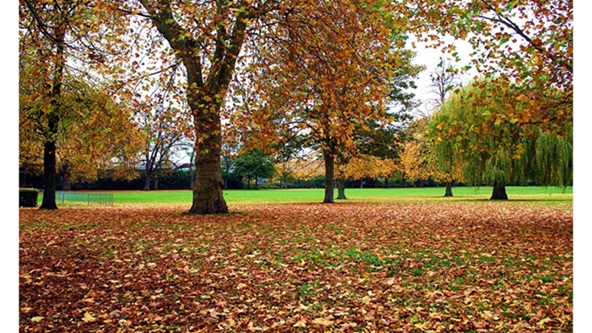.
Melancholy Hues (of Autumn)
—an ode
The third of four trimesters of the year
sees summer flag. The mercury recedes
and chilly grey replaces skies once clear,
while on Earth’s tilted axis, Autumn feeds.
From bole and trunk arboreal poisons course
through branches, twigs and into verdant leaves,
which, tainted, turn to russet, red or brown,
enlivening the sunset and the dawn.
Soon oaks and elms stand naked and forlorn,
the sycamore has shuffled off its gown;
what summer gave, approaching winter thieves
from northern climes turned cold by Nature’s force.
The days grow short, the frosty season looms,
the squirrel, in his drey, proceeds to snooze,
to dream of summers past, of springtime blooms,
midst melancholy Autumn’s rusty hues.
.
.
Paul A. Freeman is the author of Rumours of Ophir, a crime novel which was taught in Zimbabwean high schools and has been translated into German. In addition to having two novels, a children’s book and an 18,000-word narrative poem (Robin Hood and Friar Tuck: Zombie Killers!) commercially published, Paul is the author of hundreds of published short stories, poems and articles.















Enchanting autumn poem with excellent imagery and fascinating rhyme scheme with the first and forth verses using standard abab and the middle two verses reversing their rhyme scheme as abcd, xcba.
Thanks for reading and commenting, Roy. I thought I’d mix up the rhyme scheme a bit since seasons are such unique times and stretch the poem out more visibly.
I love the personification!
Thanks, Margaret. Even far from a temperate climate, I can’t resist recalling autumn in England.
A wonderful poem, Paul, with an interesting interplay between life and death, between poison which kills the leaves yet “enlivens” the sunset and dawn. The rhyme scheme is noteworthy as, in the middle two stanzas you reverse from abcd to dcba — a reversal which again suggests loss and gain. This poem is full of contrasts and contrary points of view. Well done!
Thanks for reading and commenting, Brian. As Margaret noted, I tried to add more personification to the poem in addition to the feel of arboreal life going into hibernation and being both dead and alive simultaneously.
Paul, this is a lovely ode–and my first wish in reading was to find out HOW it is an ode. Despite four stanzas, you have the classic three parts, with stanzas 2 and 3 drawn together by the rhyme scheme. And that elaboration of rhyme scheme substitutes for elaborate stanza shapes often characteristic of odes. Your vocabulary, though simple and natural, is elevated, in accord with the stately language often found in odes. The three parts do not function as usual, with contrast of strophe and antistrophe settling into the resolution of epode. Rather, your ode might be said to begin and end with strophe and antistrophe, and a center section that serves as a dramatic epode instead of a settling resolution. Thus the poem is an ode and is not an ode, with variation on each of the genre’s main features.
The personification is–just a little–like that in Keats’s “To Autumn,” but more subdued. If I think of one of his great odes here, it would be rather the “Ode on Melancholy,” where Melancholy is seated in Delight, because melancholy occurs as joy is passing away. Your poem, though, is rather gentler, departing with that cute image of the snoozing squirrel amid rusty autumnal hues.
An ode good enough to recall the master maker of English odes!
Wow! After having such a terrible day, your comment has proven the best tonic, Margaret. I’ll be mulling over your words for days if not weeks to come – at which point it will be time for a winter ‘ode’.
Thanks for reading and for your positivity.
Nice sentiments, Paul, but “four trimesters” just doesn’t make any sense.
Thanks for reading and commenting, CB.
Dictionaries define ‘trimester’ as ‘a period of three or about three months’ and the seasons of the year are three or about three months each in temperate climes; but feel free to nit-pick.
Yes, dictionaries define, and nice sentiments, Paul.
You just don’t make any sense.